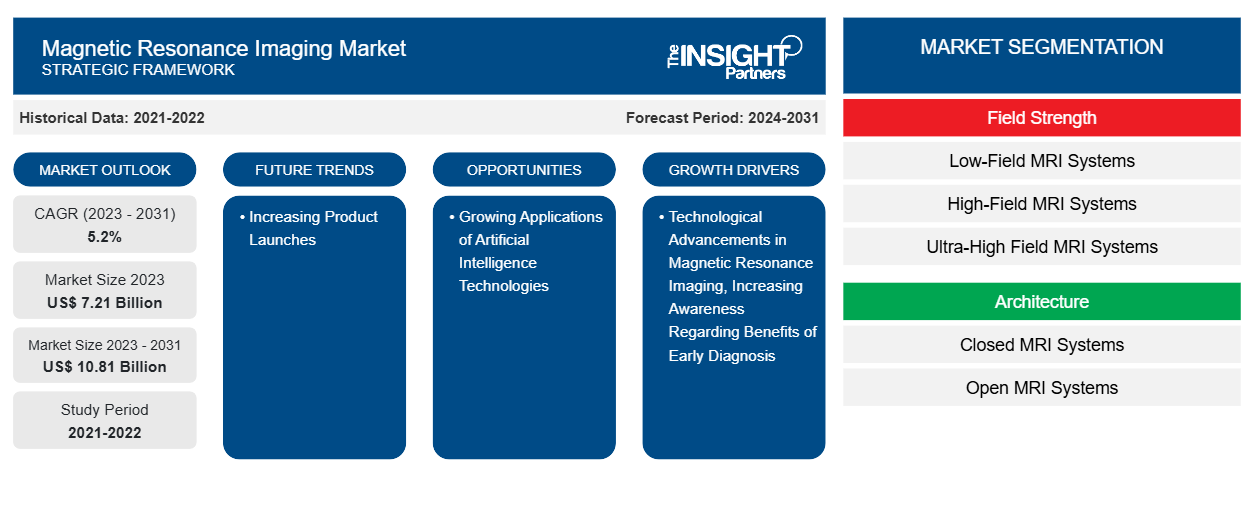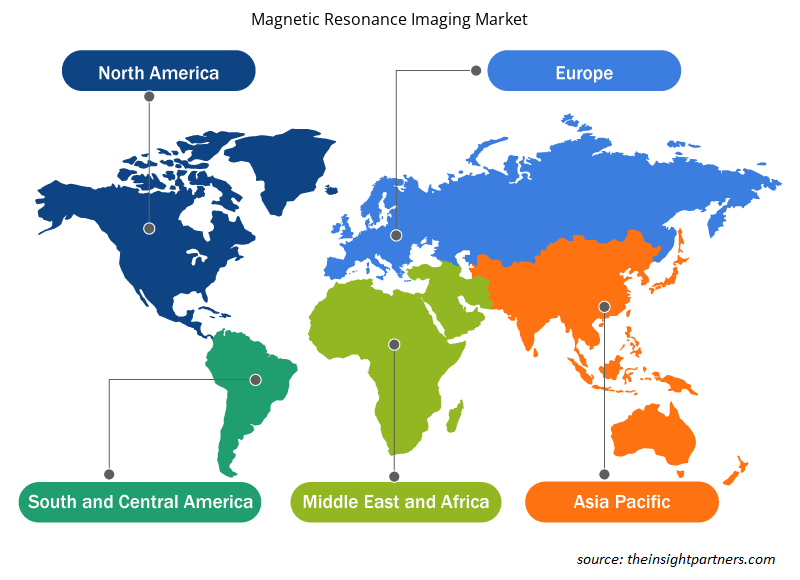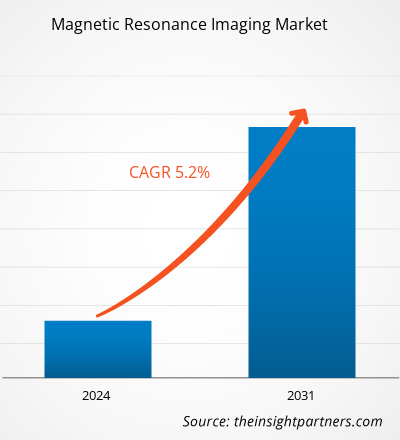The magnetic resonance imaging market size is projected to reach US$ 10.81 billion by 2031 from US$ 7.21 billion in 2023. The market is expected to register a CAGR of 5.2% in 2023–2031. Growing applications of artificial intelligence technologies serve as a key magnetic resonance imaging market trends.
Magnetic Resonance Imaging Market Analysis
The surge in aging populations, increase in the number of people having cancer, technical advancements in the field of healthcare leading to the innovation of new and cutting-edge technologies, and growing awareness regarding the importance of early diagnosis of disease, which helps in early treatment are some factors that are expanding the market growth. An increase in investments leading to the introduction of new products and funded projects for improving MRI technologies in pediatric care are anticipated to augment the market's expansion during the forecast period.
Magnetic Resonance Imaging Market Overview
Magnetic resonance imaging (MRI) is a non-invasive diagnostic imaging system that utilizes strong magnetic fields and radio waves to generate detailed images of the inside of the body. The contrast agents employed in MRI help to differentiate between benign and malignant tumors by the type of lesions produced. As chronic diseases have increased in developed and developing nations, the requirement for medical imaging has grown considerably. According to the GLOBOCAN Report 2020, ~19.29 million new cancer cases have been reported globally, along with 9.95 million reported deaths caused by the disease. As per OECD Health Statistics data, 50,000 MRI systems are installed worldwide, and over 95 million MRI scans are performed yearly globally. In April 2021, Philips participated in an imperative research project to discover a potentially revolutionary use of MRI technology in cardiology.
Customize This Report To Suit Your Requirement
You will get customization on any report - free of charge - including parts of this report, or country-level analysis, Excel Data pack, as well as avail great offers and discounts for start-ups & universities
Magnetic Resonance Imaging Market: Strategic Insights

- Get Top Key Market Trends of this report.This FREE sample will include data analysis, ranging from market trends to estimates and forecasts.
You will get customization on any report - free of charge - including parts of this report, or country-level analysis, Excel Data pack, as well as avail great offers and discounts for start-ups & universities
Magnetic Resonance Imaging Market: Strategic Insights

- Get Top Key Market Trends of this report.This FREE sample will include data analysis, ranging from market trends to estimates and forecasts.
Magnetic Resonance Imaging Market Drivers and Opportunities
Technological Advancements in Magnetic Resonance Imaging Drives the Market Growth
MRI is one of the most flexible diagnostic imaging modalities that can characterize a wide range of parameters in the living subject and provide an exquisite spatial resolution. Several recent technological developments have marked the evolution of MRI techniques over the past few years. Some of the technological advancements include the introduction of open MRI, which facilitates the efficient imaging of individuals who are overweight or claustrophobic. These advances have also improved the imaging equipment's field strength and computing capacity. Because of these characteristics, the equipment's pulse sequences have been improved, resulting in faster imaging timing, higher spatial resolution, and better imaging quality. New and technologically advanced products offered by major market players, such as Siemens' MAGNETOM Terra, the first 7T MRI system authorized for clinical usage, are a few of the technological advancements undertaken by established market players as well as new entrants to improve the quality and efficacy of MRI scans is driving the growth of the market.
Increasing Product Launches to Favor Market Growth
The growing number of product launches, coupled with the increasing adoption of high-strength systems, is one of the key opportunities offered to the players in the market. Technological innovations have led to the development and subsequent marketing of high-strength imaging equipment. In August 2023, Union Minister Dr. Jitendra Singh introduced India’s first indigenously developed, lightweight, ultrafast, affordable, high-field (1.5 Tesla) next-generation MRI scanner in New Delhi. Under the National Biopharma Mission of the Department of Biotechnology, Bengaluru-based startup Voxelgrids Innovations Pvt Ltd has developed a compact MRI Scanner to solve the country's unmet need.
Magnetic Resonance Imaging Market Report Segmentation Analysis
Key segments that contributed to the derivation of the magnetic resonance imaging market analysis are field strength, architecture, application, and end user.
- Based on field strength, the magnetic resonance imaging market is divided into low-field MRI systems, high-field MRI systems, and ultra-high field MRI systems. The high-field MRI systems segment held the largest market share in 2023. In addition, the low-field MRI systems segment is anticipated to register the highest CAGR during the forecast period.
- In terms of architecture, the market is categorized into closed MRI systems, and open MRI systems. The closed MRI systems segment held the largest market share in 2023. In addition, the open MRI systems segment is projected to register the highest CAGR during the forecast period.
- In terms of application, the market is categorized into cardiology, oncology, neurology, gastroenterology, musculoskeletal, others. The neurology segment held the largest market share in 2023. In addition, the musculoskeletal segment is projected to register the highest CAGR during the forecast period.
- Based on end user, the magnetic resonance imaging market is segmented into hospitals, ambulatory surgical centers, and diagnostic centers. The hospitals segment held the largest market share in 2023 and is estimated to register the highest CAGR during the forecast period.
Magnetic Resonance Imaging Market Share Analysis by Geography
The geographic scope of the magnetic resonance imaging market report is mainly divided into five regions: North America, Asia Pacific, Europe, Middle East & Africa, and South & Central America.
North America has dominated the magnetic resonance imaging market. The increase in the demand for innovative products from biopharmaceutical and magnetic resonance imaging companies, the presence of crucial market players, and extensive R&D conducted by numerous academic and research institutes favor the market’s growth in the region. Moreover, the increasing focus on advanced method incorporation in healthcare and the high volume of imaging procedures because of the increasing prevalence of chronic diseases further stimulate the growth of the market in North America.
Asia Pacific is projected to grow with the highest CAGR in the coming years. Rising adoption of innovative systems, a strong potential patient base, and increasing awareness about advanced diagnostics for growing cases of the disease are some of the factors that are likely to support the market growth in the region.
Magnetic Resonance Imaging Market Regional Insights
The regional trends and factors influencing the Magnetic Resonance Imaging Market throughout the forecast period have been thoroughly explained by the analysts at The Insight Partners. This section also discusses Magnetic Resonance Imaging Market segments and geography across North America, Europe, Asia Pacific, Middle East and Africa, and South and Central America.

- Get the Regional Specific Data for Magnetic Resonance Imaging Market
Magnetic Resonance Imaging Market Report Scope
| Report Attribute | Details |
|---|---|
| Market size in 2023 | US$ 7.21 Billion |
| Market Size by 2031 | US$ 10.81 Billion |
| Global CAGR (2023 - 2031) | 5.2% |
| Historical Data | 2021-2022 |
| Forecast period | 2024-2031 |
| Segments Covered |
By Field Strength
|
| Regions and Countries Covered | North America
|
| Market leaders and key company profiles |
Magnetic Resonance Imaging Market Players Density: Understanding Its Impact on Business Dynamics
The Magnetic Resonance Imaging Market is growing rapidly, driven by increasing end-user demand due to factors such as evolving consumer preferences, technological advancements, and greater awareness of the product's benefits. As demand rises, businesses are expanding their offerings, innovating to meet consumer needs, and capitalizing on emerging trends, which further fuels market growth.
Market players density refers to the distribution of firms or companies operating within a particular market or industry. It indicates how many competitors (market players) are present in a given market space relative to its size or total market value.
Major Companies operating in the Magnetic Resonance Imaging Market are:
- GE Healthcare
- Koninklijke Philips NV
- Siemens AG
- Canon Medical Systems Corporation
- Esaote SpA
- FONAR
Disclaimer: The companies listed above are not ranked in any particular order.

- Get the Magnetic Resonance Imaging Market top key players overview
Magnetic Resonance Imaging Market News and Recent Developments
The magnetic resonance imaging market is evaluated by gathering qualitative and quantitative data post primary and secondary research, which includes important corporate publications, association data, and databases. The following is a list of developments in the market for biodefense and strategies:
- Siemens Healthineers inaugurated the new manufacturing facility for MRI machines in Bengaluru. The company currently manufactures MAGNETOM Free. Star, a disruptively simple approach to high-quality MRI in India. (Source: Siemens Healthineers, Press Release, 2023)
- FUJIFILM Healthcare Americas Corp. received FDA 510(k) clearance for its new 1.5 Tesla MRI system, the ECHELON Synergy. The system employs Synergy deep learning reconstruction (DLR), Fujifilm’s proprietary DLR technology powered by artificial intelligence, to enhance the sharpness of images and acquire scans faster, contributing to higher throughput, image quality, and patient satisfaction. (Source: FUJIFILM Holdings America Corporation, Press Release, 2023)
Magnetic Resonance Imaging Market Report Coverage and Deliverables
The “Magnetic Resonance Imaging Market Size and Forecast (2021–2031)” report provides a detailed analysis of the market covering below areas:
- Market size and forecast at global, regional, and country levels for all the key market segments covered under the scope
- Market dynamics such as drivers, restraints, and key opportunities
- Key future trends
- Detailed PEST/Porter’s Five Forces and SWOT analysis
- Global and regional market analysis covering key market trends, major players, regulations, and recent market developments
- Industry landscape and competition analysis covering market concentration, heat map analysis, prominent players, and recent developments
- Detailed company profiles
- Historical Analysis (2 Years), Base Year, Forecast (7 Years) with CAGR
- PEST and SWOT Analysis
- Market Size Value / Volume - Global, Regional, Country
- Industry and Competitive Landscape
- Excel Dataset
Testimonials
Reason to Buy
- Informed Decision-Making
- Understanding Market Dynamics
- Competitive Analysis
- Identifying Emerging Markets
- Customer Insights
- Market Forecasts
- Risk Mitigation
- Boosting Operational Efficiency
- Strategic Planning
- Investment Justification
- Tracking Industry Innovations
- Aligning with Regulatory Trends
Yes! We provide a free sample of the report, which includes Report Scope (Table of Contents), report structure, and selected insights to help you assess the value of the full report. Please click on the "Download Sample" button or contact us to receive your copy.
Absolutely — analyst assistance is part of the package. You can connect with our analyst post-purchase to clarify report insights, methodology or discuss how the findings apply to your business needs.
Once your order is successfully placed, you will receive a confirmation email along with your invoice.
• For published reports: You’ll receive access to the report within 4–6 working hours via a secured email sent to your email.
• For upcoming reports: Your order will be recorded as a pre-booking. Our team will share the estimated release date and keep you informed of any updates. As soon as the report is published, it will be delivered to your registered email.
We offer customization options to align the report with your specific objectives. Whether you need deeper insights into a particular region, industry segment, competitor analysis, or data cut, our research team can tailor the report accordingly. Please share your requirements with us, and we’ll be happy to provide a customized proposal or scope.
The report is available in either PDF format or as an Excel dataset, depending on the license you choose.
The PDF version provides the full analysis and visuals in a ready-to-read format. The Excel dataset includes all underlying data tables for easy manipulation and further analysis.
Please review the license options at checkout or contact us to confirm which formats are included with your purchase.
Our payment process is fully secure and PCI-DSS compliant.
We use trusted and encrypted payment gateways to ensure that all transactions are protected with industry-standard SSL encryption. Your payment details are never stored on our servers and are handled securely by certified third-party processors.
You can make your purchase with confidence, knowing your personal and financial information is safe with us.
Yes, we do offer special pricing for bulk purchases.
If you're interested in purchasing multiple reports, we’re happy to provide a customized bundle offer or volume-based discount tailored to your needs. Please contact our sales team with the list of reports you’re considering, and we’ll share a personalized quote.
Yes, absolutely.
Our team is available to help you make an informed decision. Whether you have questions about the report’s scope, methodology, customization options, or which license suits you best, we’re here to assist. Please reach out to us at sales@theinsightpartners.com, and one of our representatives will get in touch promptly.
Yes, a billing invoice will be automatically generated and sent to your registered email upon successful completion of your purchase.
If you need the invoice in a specific format or require additional details (such as company name, GST, or VAT information), feel free to contact us, and we’ll be happy to assist.
Yes, certainly.
If you encounter any difficulties accessing or receiving your report, our support team is ready to assist you. Simply reach out to us via email or live chat with your order information, and we’ll ensure the issue is resolved quickly so you can access your report without interruption.





















 Get Free Sample For
Get Free Sample For